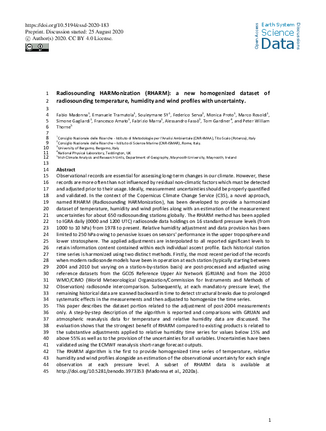Observational records are essential for assessing long-term changes in our climate. However, these records are more often than not influenced by residual non‐climatic factors which must be detected and adjusted prior to their usage. Ideally, measurement uncertainties should be properly quantified and validated. In the context of the Copernicus Climate Change Service (C3S), a novel approach, named RHARM (Radiosounding HARMonization), has been developed to provide a harmonized dataset of temperature, humidity and wind profiles along with an estimation of the measurement uncertainties for about 650 radiosounding stations globally. The RHARM method has been applied to IGRA daily (0000 and 1200 UTC) radiosonde data holdings on 16 standard pressure levels (from 1000 to 10 hPa) from 1978 to present. Relative humidity adjustment and data provision has been limited to 250 hPa owing to pervasive issues on sensors' performance in the upper troposphere and lower stratosphere. The applied adjustments are interpolated to all reported significant levels to retain information content contained within each individual ascent profile. Each historical station time series is harmonized using two distinct methods. Firstly, the most recent period of the records when modern radiosonde models have been in operation at each station (typically starting between 2004 and 2010 but varying on a station-by-station basis) are post-processed and adjusted using reference datasets from the GCOS Reference Upper Air Network (GRUAN) and from the 2010 WMO/CIMO (World Meteorological Organization/Commission for Instruments and Methods of Observation) radiosonde intercomparison. Subsequently, at each mandatory pressure level, the remaining historical data are scanned backward in time to detect structural breaks due to prolonged systematic effects in the measurements and then adjusted to homogenize the time series.
This paper describes the dataset portion related to the adjustment of post-2004 measurements only. A step-by-step description of the algorithm is reported and comparisons with GRUAN and atmospheric reanalysis data for temperature and relative humidity data are discussed. The evaluation shows that the strongest benefit of RHARM compared to existing products is related to the substantive adjustments applied to relative humidity time series for values below 15 % and above 55 % as well as to the provision of the uncertainties for all variables. Uncertainties have been validated using the ECMWF reanalysis short-range forecast outputs.
The RHARM algorithm is the first to provide homogenized time series of temperature, relative humidity and wind profiles alongside an estimation of the observational uncertainty for each single observation at each pressure level. A subset of RHARM dataisavailable at https://doi.org/10.5281/zenodo.3973353 (Madonnaet al., 2020a)

